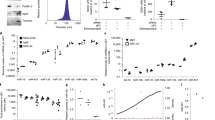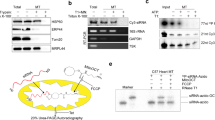Abstract
Small interfering RNAs (siRNAs) and microRNAs (miRNAs) are sequence-specific post-transcriptional regulators of gene expression. Although major components of the RNA interference (RNAi) pathway have been identified, regulatory mechanisms for this pathway remain largely unknown. Here we demonstrate that the RNAi pathway can be modulated intracellularly by small molecules. We have developed a cell-based assay to monitor the activity of the RNAi pathway and find that the small-molecule enoxacin (Penetrex) enhances siRNA-mediated mRNA degradation and promotes the biogenesis of endogenous miRNAs. We show that this RNAi-enhancing activity depends on the trans-activation-responsive region RNA-binding protein. Our results provide a proof-of-principle demonstration that small molecules can be used to modulate the activity of the RNAi pathway. RNAi enhancers may be useful in the development of research tools and therapeutics.
This is a preview of subscription content, access via your institution
Access options
Subscribe to this journal
Receive 12 print issues and online access
$209.00 per year
only $17.42 per issue
Buy this article
- Purchase on Springer Link
- Instant access to full article PDF
Prices may be subject to local taxes which are calculated during checkout






Similar content being viewed by others
References
Hannon, G.J. RNA interference. Nature 418, 244–251 (2002).
Bartel, D.P. MicroRNAs: genomics, biogenesis, mechanism, and function. Cell 116, 281–297 (2004).
Plasterk, R.H. Micro RNAs in animal development. Cell 124, 877–881 (2006).
Zamore, P.D. & Haley, B. Ribo-gnome: the big world of small RNAs. Science 309, 1519–1524 (2005).
Dykxhoorn, D.M. & Lieberman, J. The silent revolution: RNA interference as basic biology, research tool, and therapeutic. Annu. Rev. Med. 56, 401–423 (2005).
Dykxhoorn, D.M. & Lieberman, J. Running interference: prospects and obstacles to using small interfering RNAs as small molecule drugs. Annu. Rev. Biomed. Eng. 8, 377–402 (2006).
Tiscornia, G., Singer, O., Ikawa, M. & Verma, I.M. A general method for gene knockdown in mice by using lentiviral vectors expressing small interfering RNA. Proc. Natl. Acad. Sci. USA 100, 1844–1848 (2003).
Hutvagner, G., Simard, M.J., Mello, C.C. & Zamore, P.D. Sequence-specific inhibition of small RNA function. PLoS Biol. 2, E98 (2004).
Patel, S.S. & Spencer, C.M. Enoxacin: a reappraisal of its clinical efficacy in the treatment of genitourinary tract infections. Drugs 51, 137–160 (1996).
Pasquinelli, A.E. Demystifying small RNA pathways. Dev. Cell 10, 419–424 (2006).
Bhanot, S.K., Singh, M. & Chatterjee, N.R. The chemical and biological aspects of fluoroquinolones: reality and dreams. Curr. Pharm. Des. 7, 311–335 (2001).
Hopper, D.C. & Wolfson, J.S. Quinolone Antimicrobial Agents 3rd edn. (ASM Press, Washington, DC; 2003).
Mitscher, L.A. Bacterial topoisomerase inhibitors: quinolone and pyridone antibacterial agents. Chem. Rev. 105, 559–592 (2005).
Schaeffer, A.J. The expanding role of fluoroquinolones. Am. J. Med. 113 Suppl 1A, 45S–54S (2002).
Dalhoff, A. & Shalit, I. Immunomodulatory effects of quinolones. Lancet Infect. Dis. 3, 359–371 (2003).
Eriksson, E., Forsgren, A. & Riesbeck, K. Several gene programs are induced in ciprofloxacin-treated human lymphocytes as revealed by microarray analysis. J. Leukoc. Biol. 74, 456–463 (2003).
Rand, T.A., Ginalski, K., Grishin, N.V. & Wang, X. Biochemical identification of Argonaute 2 as the sole protein required for RNA-induced silencing complex activity. Proc. Natl. Acad. Sci. USA 101, 14385–14389 (2004).
Liu, J. et al. Argonaute2 is the catalytic engine of mammalian RNAi. Science 305, 1437–1441 (2004).
Bernstein, E., Caudy, A.A., Hammond, S.M. & Hannon, G.J. Role for a bidentate ribonuclease in the initiation step of RNA interference. Nature 409, 363–366 (2001).
Chendrimada, T.P. et al. TRBP recruits the Dicer complex to Ago2 for microRNA processing and gene silencing. Nature 436, 740–744 (2005).
Jiang, F. et al. Dicer-1 and R3D1-L catalyze microRNA maturation in Drosophila. Genes Dev. 19, 1674–1679 (2005).
Forstemann, K. et al. Normal microRNA maturation and germ-line stem cell maintenance requires Loquacious, a double-stranded RNA-binding domain protein. PLoS Biol. 3, e236 (2005).
Okabe, M., Ikawa, M., Kominami, K., Nakanishi, T. & Nishimune, Y. 'Green mice' as a source of ubiquitous green cells. FEBS Lett. 407, 313–319 (1997).
Jackson, A.L. et al. Widespread siRNA “off-target” transcript silencing mediated by seed region sequence complementarity. RNA 12, 1179–1187 (2006).
Lim, L.P. et al. Microarray analysis shows that some microRNAs downregulate large numbers of target mRNAs. Nature 433, 769–773 (2005).
Jing, Q. et al. Involvement of microRNA in AU-rich element-mediated mRNA instability. Cell 120, 623–634 (2005).
Katoh, T. & Suzuki, T. Specific residues at every third position of siRNA shape its efficient RNAi activity. Nucleic Acids Res. 35, e27 (2007).
Duan, R., Pak, C. & Jin, P. Single nucleotide polymorphism associated with mature miR-125a alters the processing of pri-miRNA. Hum. Mol. Genet. 16, 1124–1131 (2007).
Chu, C.Y. & Rana, T.M. Translation repression in human cells by microRNA-induced gene silencing requires RCK/p54. PLoS Biol. 4, e210 (2006).
Hutvagner, G. & Zamore, P.D. A microRNA in a multiple-turnover RNAi enzyme complex. Science 297, 2056–2060 (2002).
Acknowledgements
We would like to thank S. Warren, S. Chang, K. Garber and C. Strauss for their helpful discussions and critical reading of the manuscript and H. Ju for technical assistance. We thank I. Verma, J. Belasco and G. Hannon for providing us the plasmids. Q.L. is a Damon Runyon Scholar (DRS-43) and is supported by the Welch Foundation (I-1608). P.J. is supported by NIH grants (NS051630 and MH076090). P.J. is the recipient of a Beckman Young Investigator Award and a Basil O'Connor Scholar Research Award and is an Alfred P. Sloan Research Fellow in Neuroscience.
Author information
Authors and Affiliations
Contributions
P.J. designed the research. G.S. conducted the chemical screen and identified the small molecule presented in this paper. G.S. and Y.L. performed the majority of mechanistic experiments. J.Z., L.L., Z.S. and C.H. performed chemical synthesis. G.S., Y.L., W.L., M.A.F., A.M.K. and C.W. performed additional testing on the compound. K.E.S. and R.D. performed miRNA profiling and developed the reporter system. A.W.S.C., Z.P. and Q.L. provided some reagents used in this paper. G.S., Y.L. and P.J. wrote the paper.
Corresponding author
Ethics declarations
Competing interests
P.J. is the scientific founder of Effigene Pharmaceuticals, Inc. Effigene is engaged in the development of RNAi modulators.
Supplementary information
Supplementary Text and Figures
Supplementary Figures 1–9, Tables 1–4, Methods (PDF 3440 kb)
Rights and permissions
About this article
Cite this article
Shan, G., Li, Y., Zhang, J. et al. A small molecule enhances RNA interference and promotes microRNA processing. Nat Biotechnol 26, 933–940 (2008). https://doi.org/10.1038/nbt.1481
Received:
Accepted:
Published:
Issue Date:
DOI: https://doi.org/10.1038/nbt.1481



